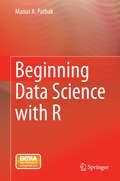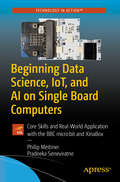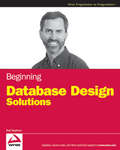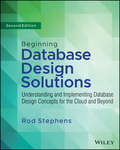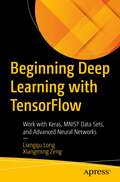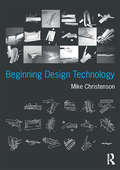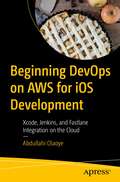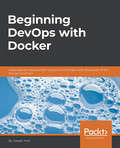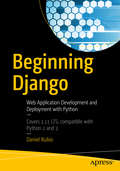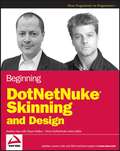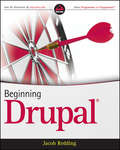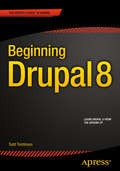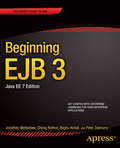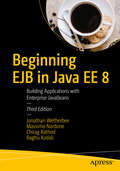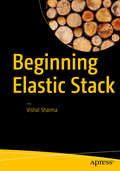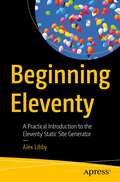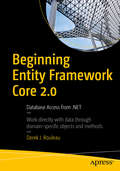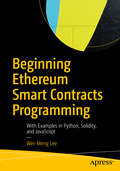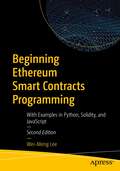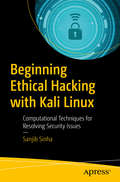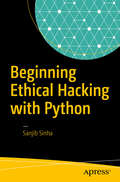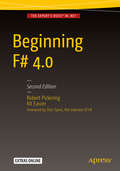- Table View
- List View
Beginning Data Science in R 4: Data Analysis, Visualization, and Modelling for the Data Scientist
by Thomas MailundDiscover best practices for data analysis and software development in R and start on the path to becoming a fully-fledged data scientist. Updated for the R 4.0 release, this book teaches you techniques for both data manipulation and visualization and shows you the best way for developing new software packages for R. Beginning Data Science in R 4, Second Edition details how data science is a combination of statistics, computational science, and machine learning. You’ll see how to efficiently structure and mine data to extract useful patterns and build mathematical models. This requires computational methods and programming, and R is an ideal programming language for this. Modern data analysis requires computational skills and usually a minimum of programming. After reading and using this book, you'll have what you need to get started with R programming with data science applications. Source code will be available to support your next projects as well.Source code is available at github.com/Apress/beg-data-science-r4.What You Will LearnPerform data science and analytics using statistics and the R programming languageVisualize and explore data, including working with large data sets found in big dataBuild an R packageTest and check your codePractice version controlProfile and optimize your codeWho This Book Is ForThose with some data science or analytics background, but not necessarily experience with the R programming language.
Beginning Data Science with R
by Manas A. Pathak"We live in the age of data. In the last few years, the methodology of extracting insights from data or "data science" has emerged as a discipline in its own right. The R programming language has become one-stop solution for all types of data analysis. The growing popularity of R is due its statistical roots and a vast open source package library. The goal of "Beginning Data Science with R" is to introduce the readers to some of the useful data science techniques and their implementation with the R programming language. The book attempts to strike a balance between the how: specific processes and methodologies, and understanding the why: going over the intuition behind how a particular technique works, so that the reader can apply it to the problem at hand. This book will be useful for readers who are not familiar with statistics and the R programming language.
Beginning Data Science, IoT, and AI on Single Board Computers: Core Skills and Real-World Application with the BBC micro:bit and XinaBox
by Pradeeka Seneviratne Philip MeitinerLearn to use technology to undertake data science and to leverage the Internet of Things (IoT) in your experimentation. Designed to take you on a fascinating journey, this book introduces the core concepts of modern data science. You'll start with simple applications that you can undertake on a BBC micro:bit and move to more complex experiments with additional hardware. The skills and narrative are as generic as possible and can be implemented with a range of hardware options. One of the most exciting and fastest growing topics in education is data science. Understanding how data works, and how to work with data, is a key life skill in the 21st century. In a world driven by information it is essential that students are equipped with the tools they need to make sense of it all. For instance, consider how data science was the key factor that identified the dangers of climate change -- and continues to help us identify and react to the threats it presents. This book explores the power of data and how you can apply it using hardware you have at hand. You'll learn the core concepts of data science, how to apply them in the real world and how to utilize the vast potential of IoT. By the end, you'll be able to execute sophisticated and meaningful data science experiments - why not become a citizen scientist and make a real contribution to the fight against climate change. There is something of a digital revolution going these days, especially in the classroom. With increasing access to microprocessors, classrooms are are incorporating them more and more into lessons. Close to 5 million BBC micro:bits will be in the hands of young learners by the end of the year and millions of other devices are also being used by educators to teach a range of topics and subjects. This presents an opportunity: microprocessors such as micro:bit provide the perfect tool to use to build 21st century data science skills. Beginning Data Science and IoT on the BBC micro:bit provides you with a solid foundation in applied data science.What You'll Learn · Use sensors with a microprocessor to gather or "create" data · Extract, tabulate, and utilize data it from the microprocessor · Connect a microprocessor to an IoT platform to share and then use the data we collect · Analyze and convert data into information Who This Book Is For Educators, citizen scientists, and tinkerers interested in an introduction to the concepts of IoT and data on a broad scale.
Beginning Database Design Solutions
by Rod StephensThe vast majority of software applications use relational databases that virtually every application developer must work with. This book introduces you to database design, whether you're a DBA or database developer. You'll discover what databases are, their goals, and why proper design is necessary to achieve those goals. Additionally, you'll master how to structure the database so it gives good performance while minimizing the chance for error. You will learn how to decide what should be in a database to meet the application's requirements.
Beginning Database Design Solutions: Understanding and Implementing Database Design Concepts for the Cloud and Beyond
by Rod StephensA concise introduction to database design concepts, methods, and techniques in and out of the cloud In the newly revised second edition of Beginning Database Design Solutions: Understanding and Implementing Database Design Concepts for the Cloud and Beyond, Second Edition, award-winning programming instructor and mathematician Rod Stephens delivers an easy-to-understand guide to designing and implementing databases both in and out of the cloud. Without assuming any prior database design knowledge, the author walks you through the steps you’ll need to take to understand, analyze, design, and build databases. In the book, you’ll find clear coverage of foundational database concepts along with hands-on examples that help you practice important techniques so you can apply them to your own database designs, as well as: Downloadable source code that illustrates the concepts discussed in the book Best practices for reliable, platform-agnostic database design Strategies for digital transformation driven by universally accessible database design An essential resource for database administrators, data management specialists, and database developers seeking expertise in relational, NoSQL, and hybrid database design both in and out of the cloud, Beginning Database Design Solutions is a hands-on guide ideal for students and practicing professionals alike.
Beginning Database Programming Using ASP.NET Core 3: With MVC, Razor Pages, Web API, jQuery, Angular, SQL Server, and NoSQL
by Bipin JoshiHit the ground running with this book to quickly learn the fundamentals of HTML form processing, user authentication, and database CRUD (Create, Read, Update, and Delete) operations using the ASP.NET Core family of technologies. You will utilize cutting-edge and popular technology options from both the server side and client side to help you achieve your web application goals as quickly as possible. Developers who want to learn ASP.NET Core and complementary technologies are often overwhelmed by the large number of options involved in building modern web applications. This book introduces you to the most popular options so that you can confidently begin working on projects in no time. You will learn by example, building a sample application that demonstrates how the same application can be built using different options. This experiential approach will give you the basic skills and knowledge to understand how the options work together so that you can make an informed decision about the available choices, their trade-offs, and code level comparison. After reading this book, you will be able to choose your selected learning path. What You Will LearnDevelop data entry forms in ASP.NET Core, complete with validations and processingPerform CRUD operations using server-side options: ASP.NET Core MVC, Razor Pages, Web APIs, and BlazorPerform CRUD operations using client-side options: jQuery and AngularSecure web applications using ASP.NET Core Identity, cookie authentication, and JWT authenticationUse RDBMS and NoSQL data stores: SQL Server, Azure SQL Database, Azure Cosmos DB, and MongoDB for CRUD operationsDeploy ASP.NET Core web applications to IIS and Azure App Service Who This Book Is ForDevelopers who possess a basic understanding of ASP.NET and how web applications work. Some experience with Visual Studio 2017 or higher, C#, and JavaScript is helpful.
Beginning Deep Learning with TensorFlow: Work with Keras, MNIST Data Sets, and Advanced Neural Networks
by Liangqu Long Xiangming ZengIncorporate deep learning into your development projects through hands-on coding and the latest versions of deep learning software, such as TensorFlow 2 and Keras. The materials used in this book are based on years of successful online education experience and feedback from thousands of online learners. You’ll start with an introduction to AI, where you’ll learn the history of neural networks and what sets deep learning apart from other varieties of machine learning. Discovery the variety of deep learning frameworks and set-up a deep learning development environment. Next, you’ll jump into simple classification programs for hand-writing analysis. Once you’ve tackled the basics of deep learning, you move on to TensorFlow 2 specifically. Find out what exactly a Tensor is and how to work with MNIST datasets. Finally, you’ll get into the heavy lifting of programming neural networks and working with a wide variety of neural network types such as GANs and RNNs. Deep Learning is a new area of Machine Learning research widely used in popular applications, such as voice assistant and self-driving cars. Work through the hands-on material in this book and become a TensorFlow programmer! What You'll LearnDevelop using deep learning algorithmsBuild deep learning models using TensorFlow 2Create classification systems and other, practical deep learning applicationsWho This Book Is ForStudents, programmers, and researchers with no experience in deep learning who want to build up their basic skillsets. Experienced machine learning programmers and engineers might also find value in updating their skills.
Beginning Design Technology
by Mike ChristensonBeginning Design Technology introduces how design technologies work together, including tools, materials, and software, such as Adobe Photoshop, Adobe Illustrator, Autodesk AutoCAD, and others. It teaches you how to think about each design tool, whether a software program or physical modelmaking, so that you will select one for its strengths for a specific task and know when and how to combine it with other tools. Topics include working with building information, texturing digital and physical artifacts, translating information from one form or file format to another, constructing at full-scale, and making digital and physical models. Chapter Summaries, exercises, discussion questions, a glossary, an appendix of common software commands, and an annotated bibliography will help you find what you need quickly and put the information into practice.
Beginning DevOps on AWS for iOS Development: Xcode, Jenkins, and Fastlane Integration on the Cloud
by Abdullahi OlaoyeApply the principles of DevOps in software development—automated builds, automated tests, and continuous deployment and delivery—to iOS application development on Amazon Web Services (AWS) cloud. This book provides detailed walkthroughs and example source code is provided for the concepts discussed so you can put theory into practical application.You'll start by building a basic iOS application and then dive deep into key AWS Developer tools and services to see how they can be used in iOS application development. Then review the details of the integration of these fully managed AWS services with open-source tools such as Jenkins and Fastlane that allow developers to get the best of both worlds and further help to enhance and increase agility in the development lifecycle of iOS apps. You'll also investigate the Amazon EC2 Mac instance, which allows you to run XCode in a cloud environment for the first time to leverage the flexibility, elasticity, and scale of AWS. It also allows for seamless integration of XCode with fully managed AWS Services from source code control to application deployment. Finally, the book covers how a fully managed Continuous Integration Continuous Deployment (CICD) pipeline can be used to orchestrate all the different components of iOS application development to achieve a fully automated development lifecycle. Get started building your iOS applications using a fully automated process on the AWS Cloud today!What You'll LearnBuild an iOS application using AWS DevOps tools Incorporate continuous deployment in your iOS application development Integrate AWS tooling with Xcode and open source tools such as Jenkins and FastlaneWho This Book Is ForiOS application developers wanting to incorporate DevOps and Cloud Architecture into their development process.
Beginning DevOps with Docker: Automate the deployment of your environment with the power of the Docker toolchain
by Joseph MuliAutomate the deployment of your environment with the power of the Docker toolchainKey Features Written and reviewed by expert Docker developers The book precisely covers all the essential topics such as building images and managing container swarms required in day to day use for Docker The book includes activities on the docker CLI and exercises such as writing Dockerfiles for Python which will allow you to reinforce the concepts coveredBook DescriptionDevOps with Docker outlines the power of containerization and the influence this innovation has on development teams and general operations. We also get to understand what DevOps really is, the principles involved and how the process contributes to product health, by implementing a Docker workflow. We will learn to interpret Dockerfile syntax, build images and set up containers and images. In addition, we will deploy a Docker image to the Docker Hub. Docker is an open source containerization tool, that makes it easier to streamline product delivery. It helps reduce the time taken to get from a whiteboard sketch of the business to a money-back implementation.This fast-paced book is a perfect amalgamation of theory and hands-on exercises. The book will take you through the basics of Docker and DevOps and why and how they integrate. You will then understand what containers are, and how to create and manage them. Next, we will work on the docker-compose file and CLI. Then we will move to set up a network with the docker-compose tool. Gradually you will learn how to scale a delivery pipeline and multiple deployments with Docker. Lastly, you will grasp the concept of orchestration and learn to implement the delivery of containerized applications.What you will learn Understand how to effectively design and build containers for different applications Set up an environment for testing, avoiding environment mismatch that is breaking production Set up and manage a multi-tier environment. Run, debug, and experiment with applications in a containerWho this book is forThe book is crafted for developers, system architects, junior and mid-level site reliability engineers interested in adapting a docker workflow. They are also required to have a basic knowledge of UNIX concepts such as ssh, ports and logs.
Beginning Django: Web Application Development and Deployment with Python
by Daniel RubioDiscover the Django web application framework and get started building Python-based web applications. This book takes you from the basics of Django all the way through to cutting-edge topics such as creating RESTful applications. Beginning Django also covers ancillary, but essential, development topics, including configuration settings, static resource management, logging, debugging, and email. Along with material on data access with SQL queries, you'll have all you need to get up and running with Django 1. 11 LTS, which is compatible with Python 2 and Python 3. Once you've built your web application, you'll need to be the admin, so the next part of the book covers how to enforce permission management with users and groups. This technique allows you to restrict access to URLs and content, giving you total control of your data. In addition, you'll work with and customize the Django admin site, which provides access to a Django project's data. After reading and using this book, you'll be able to build a Django application top to bottom and be ready to move on to more advanced or complex Django application development. What You'll Learn Get started with the Django framework Use Django views, class-based views, URLs, middleware, forms, templates, and Jinja templates Take advantage of Django models, including model relationships, migrations, queries, and forms Leverage the Django admin site to get access to the database used by a Django project Deploy Django REST services to serve as the data backbone for mobile, IoT, and SaaS systems Who This Book Is For Python developers new to the Django web application development framework and web developers new to Python and Django.
Beginning DotNetNuke Skinning and Design
by Andrew Hay Shaun WalkerDotNetNuke is an open source framework built on top of the ASP.Net platform. While this system offers an impressive set of out-of-the-box features for public and private sites, it also includes a compelling story for folks who want to present a unique look and feel to visitors.The skinning engine inside of DotNetNuke has strengthened over the course of several years and hundreds of thousands of registered users. The success of its skin and module developer community is another key indicator of the depth and breadth of this technology. The Core Team responsible for the DotNetNuke brand has gone to great lengths to enable a predictable and positive experience for both the visitors of the site and the developers who build them.Note: CD-ROM/DVD and other supplementary materials are not included as part of eBook file.
Beginning Drupal
by Jacob ReddingA thorough introduction that lessens the learning curve to building sites with Drupal 7 Drupal 7 is the latest version of the free, open source content management system Drupal. A powerful content management system and framework Drupal has an unfortunate reputation of having a steep learning curve. This guide to Drupal 7 methodically demystifies Drupal and shortening the learning curve. Author Jacob Redding is deeply embedded in the Drupal community, and walks first-time Drupal developers through the installation and configuration of a Drupal system. In-depth information on key areas of Drupal explore the Drupal hook system, Drupal's theming layer, and Drupal's API. You'll also get sample code, and lessons that guide you through various aspects of Drupal. Introduces you to every aspect of Drupal 7 Demystifies key areas of Drupal and shortens the learning curve for even the most novice beginner Features lessons and sample code that offer extra insight into a Drupal web site Exploring simple single website installations and more advanced multiple site installations that share users and/or content. Addresses how to use Drupal's theming layer to your advantage. With this comprehensive and clear book by your side, you will quickly learn to leverage Drupal's impressive power. Note: CD-ROM/DVD and other supplementary materials are not included as part of eBook file.
Beginning Drupal 8
by Todd TomlinsonBeginning Drupal 8 teaches you how to build, maintain, and manage Drupal 8-based web sites. The book covers what Drupal is, using Drupal when building a new web site, installing and configuring Drupal, creating and managing content, managing users, adding functionality to your web site through Drupal modules, and advanced topics on using themes, panels, and views. The book also builds practical examples of common Drupal sites, such as a company website, a community website, and a commerce website, that you can take and expand on to create your own Drupal 8 sites. By reading this book, you will understand the power of the Drupal platform, and why you should be using Drupal if you're not already. Through following the samples in the book, you will quickly build your confidence and your ability to use Drupal. Beginning Drupal 8 gives you the knowledge necessary to build, deploy, and manage web sites on Drupal 8. What you'll learn What Drupal is and why you should use it How to install a basic Drupal web site from scratch How to create content in your new Drupal web site How to manage users on your new Drupal web site How to change the look and feel of your new Drupal web site through themes How to install and configure modules Who this book is for This book is for nontechnical users who want to use Drupal 8 to manage content, as well as developers who are new to Drupal 8. Table of Contents Introduction to Drupal Creating and Managing Content Creating and Managing Users Creating and Using Taxonomy Creating Content Types Creating and Using Views Creating and Using Page Payouts Creating and Using Menus Creating and Using Blocks Theming Your Site Making Your Site Responsive Extending Your Site Through Contributed Modules The Anatomy of a Module Using Multilingual Administering Your Drupal Site Using Drush Using Git Putting It All Together Building a Blog Site Building a Company Website Building a Community Website Building a Commerce Website App A: Modules App B: Learn More
Beginning EJB 3: Java EE 7 Edition (Beginning: From Novice To Professional Ser.)
by Jonathan Wetherbee Chirag Rathod Raghu Kodali Peter ZadroznyDevelop powerful, standards-based, back-end business logic with Beginning EJB 3, Java EE 7 Edition. Led by an author team with 20 years of combined Enterprise JavaBeans experience, you'll learn how to use the new EJB 3. 2 APIs. You'll gain the knowledge and skills you'll need to create the complex enterprise applications that run today's transactions and more. Targeted at Java and Java EE developers, with and without prior EJB experience, Beginning EJB 3 is packed with practical insights, strategy tips, and code examples. As each chapter unfolds, you'll not only explore a new area of the spec; you'll also see how you can apply it to your own applications through specific examples. Beginning EJB 3 will serve not only as a reference, but it will also function as a how-to guide and repository of practical examples to which you can refer as you build your own applications. It will help you harness the power of EJBs and take your Java EE 7 development to the next level. What you'll learn How to employ session beans, message-driven beans, and entity beans How to use the updated EJB 3 persistence and object-relational mappings How to choose which EJB option is right for your application How to enrich your application's behavior with CDI services How to test the EJB container inside and out How to migrate from older EJB to the newest EJB APIs Who this book is for This book is for those Java and Java EE developers with and without prior EJB experience. Table of Contents Introduction to the EJB 3 Architecture Session Beans Entities and the Java Persistence API Advanced Persistence Features Message-Driven Beans EJB and Web Services Integrating Session Beans, Entities, Message-Driven Beans, and Web Services Transaction Management EJB Performance and Testing Context and Dependency Injection (CDI) Packaging and Deployment EJB Client Applications EJB Runtime Environments
Beginning EJB in Java EE 8: Building Applications With Enterprise Javabeans
by Massimo Nardone Jonathan Wetherbee Chirag Rathod Raghu KodaliBuild powerful back-end business logic and complex Enterprise JavaBeans (EJB)-based applications using Java EE 8, Eclipse Enterprise for Java (EE4J), Web Tools Project (WTP), and the Microprofile platform. Targeted at Java and Java EE developers, with or without prior EJB experience, this book is packed with practical insights, strategy tips, and code examples. As each chapter unfolds, you'll see how you can apply the new EJB spec to your own applications through specific examples.Beginning EJB in Java EE 8 serves not only as a reference, but also as a how-to guide and repository of practical examples to which you can refer as you build your own applications. It will help you harness the power of EJBs and take your Java EE 8 development to the next level. You'll gain the knowledge and skills you’ll need to create the complex enterprise applications that run today's transactions and more.What You'll LearnBuild applications with Enterprise JavaBeans (EJBs) in the new Java EE 8 platformDiscover when to use EJBs over contexts and dependency injectionUse message-driven beans to do tasks asynchronouslyIntegrate EJBs with microservices using the new Eclipse Microprofile projectManage complex enterprise transactions and much moreWho This Book Is ForJava programmers new to enterprise development and for those who may have experience with EJBs but are new to Java EE 8, EE4J, and related Eclipse projects.
Beginning Elastic Stack
by Vishal SharmaLearn how to install, configure and implement the Elastic Stack (Elasticsearch, Logstash and Kibana) – the invaluable tool for anyone deploying a centralized log management solution for servers and apps. You will see how to use and configure Elastic Stack independently and alongside Puppet. Each chapter includes real-world examples and practical troubleshooting tips, enabling you to get up and running with Elastic Stack in record time. Fully customizable and easy to use, Elastic Stack enables you to be on top of your servers all the time, and resolve problems for your clients as fast as possible. Supported by Puppet and available with various plugins. Get started with Beginning Elastic Stack today and see why many consider Elastic Stack the best option for server log management.What You Will Learn:Install and configure LogstashUse Logstash with Elasticsearch and KibanaUse Logstash with Puppet and ForemanCentralize data processingWho This Book Is For:Anyone working on multiple servers who needs to search their logs using a web interface. It is ideal for server administrators who have just started their job and need to look after multiple servers efficiently.
Beginning Eleventy: A Practical Introduction to the Eleventy Static Site Generator
by Alex LibbyLeverage the power of Eleventy to quickly produce static sites that are efficient and fast. This project-oriented book simplifies the process of setting up Eleventy and manipulating content, using little more than a text editor or free software. It will equip you with a starting tool set that you can use to develop future projects or incorporate into your existing workflow. More importantly, you'll take websites to the next level, reducing the reliance on tools that are bloated, prone to being hacked and not the most efficient. Beginning Eleventy is an excellent resource for getting acquainted with creating and manipulating blogs using a static site generator approach. It takes the view that you don’t have to create something complex and unwieldy; you can build something quickly, then extend it using the power of the API and plugins over time, without sacrificing speed or features. What You’ll Learn:Implement the Eleventy framework in a projectExplore some of the options for customizing content using the frameworkGain an appreciation of pointers around maintenance requirements, and how this might compare to other blog systemsWork through some example projects, to help build up a working blog from standalone demos to implementing with other tools or libraries This Book Is For?Website developers who are already familiar with JavaScript, who are looking for a fast and simple framework to deliver high quality results fastDevelopers who are looking to leverage the Eleventy framework to quickly create an online blog using little more than a text editor, producing optimized content in modern browsers using tools they will already haveThose in agile development teams, where time is of the essence and need to deliver high quality results quickly
Beginning Entity Framework Core 2.0: Database Access From . Net
by Derek J. RouleauUse the valuable Entity Framework Core 2.0 tool in ASP.NET and the .NET Framework to eliminate the tedium around accessing databases and the data they contain.Entity Framework Core 2.0 greatly simplifies access to relational databases such as SQL Server that are commonly deployed in corporate settings. By eliminating tedious data access code that developers are otherwise forced to use, Entity Framework Core 2.0 enables you to work directly with the data in a database through domain-specific objects and methods. Beginning Entity Framework Core 2.0 is a carefully designed tutorial. Throughout the book you will encounter examples that you can use in your day-to-day coding, and you will build a solid foundation on which to create database-backed applications. If you are looking for a way to get started without getting buried under details you are only going to forget, then this is the book for you. The author aims to leave you comfortably able to connect to, access, modify, and delete data from a relational database. The book provides a clear, straightforward approach and includes code that you can look back at months later and understand. What You'll LearnStudy easy-to-follow, real-world examples you can use every dayFocus on DbContext and the Database First approachUnderstand how to work with single and multiple tablesUse the LINQ query language to manipulate dataWho This Book Is ForC# and ASP.NET programmers looking for an easier way of accessing data in a relational database than writing in SQL—a way that meshes better into object-oriented application development
Beginning Entity Framework Core 5: From Novice to Professional
by Eric VogelUse the code-driven approach of Entity Framework Core 5 to build a functional web application that accesses a database on the backend server. This book covers the common use cases of Entity Framework that a developer needs to master in order to begin building applications that run against a database. Throughout the book you will be shown how to use Entity Framework Core 5 by implementing a simple ASP.NET Core Razor Pages line-of-business application. This example application will be similar to those you might write yourself and deploy to your users on a web or intranet site via a browser. This book takes a code-first approach in which your database will be created and seeded programmatically. You won’t need to create the database through your database engine’s interface. Instead, you will be shown how to define your data model in Entity Framework, and then let Entity Framework do the work of creating your database and schema for you. From there you will learn how to seed your database with example data, then to implement the common, so-called CRUD operations consisting of creating, retrieving, updating, and deleting rows of data. By the end of the book you will have built a well-designed application that you can use as the basis for future applications that you create in your job. What You Will LearnDownload and install Entity Framework Core 5Perform create, read, update, and delete (CRUD) operationsCreate and seed a database with example data using Entity Framework Core 5Incrementally add new database functionality through Entity Framework Core 5 migrationsRecognize when to take advantage of new features introduced in Entity Framework Core 5Deliver line-of-business applications using ASP.NET Core that run in a browserWho This Books Is ForDevelopers who are familiar with C# and the .NET Framework who want to learn database access using Entity Framework Core 5. For developers creating web-based, line-of-business applications who want to create those applications more quickly and efficiently when databases are involved.
Beginning Ethereum Smart Contracts Programming: With Examples in Python, Solidity, and JavaScript
by Wei-Meng LeeUse this book to write an Ethereum Blockchain Smart Contract, test it, deploy it, and create a web application to interact with your smart contract.Beginning Ethereum Smart Contracts Programming is your fastest and most efficient means of getting started if you are unsure where to begin and how to connect to the Ethereum Blockchain. The book begins with a foundational discussion of blockchain and the motivation behind it. From there, you will get up close and personal with the Ethereum Blockchain, learning how to use an Ethereum client (geth) to connect to the Ethereum Blockchain to perform transactions such as sending Ethers to another account. You will learn about smart contracts without having to wade through tons of documentation. Author Lee’s “learn-by-doing” approach will allow you to be productive and feel confident in your ability in no time. The last part of this book covers tokens, a topic that has taken the cryptocurrency market by storm.Sample code in Python, Solidity, and JavaScript is provided in the book and online.What You'll LearnUnderstand the basic premise of blockchain and “record keeping” in a peer-to-peer networkExperience blockchain in action by creating your own blockchain using PythonKnow the foundation of smart contracts programming and how to deploy and test smart contractsWork on a case study to illustrate the use of blockchainBe familiar with tokens, and how to create and launch your own ICO digital tokenWrite smart contracts that transact using tokensWho This Book Is ForThose who want to get started quickly with Ethereum Smart Contracts programming. Basic programming knowledge and an understanding of Python or JavaScript is recommended.
Beginning Ethereum Smart Contracts Programming: With Examples in Python, Solidity, and JavaScript
by Wei-Meng LeeUse this book to write an Ethereum blockchain smart contract, test it, deploy it, and create a web application to interact with your smart contract. This new edition has been expanded and updated to cover web3.js APIs, additional Consensus Protocols, non-Fungible Tokens (NFTs), developing NFT tokens using ERC-721, and more!Beginning Ethereum Smart Contracts Programming, second edition is your fastest and most efficient means of getting started if you are unsure where to begin and how to connect to the Ethereum blockchain. The book begins with a foundational discussion of blockchain and the motivation behind it. From there, you will get up close and personal with the Ethereum blockchain, learning how to use an Ethereum client (geth) to create a private Ethereum blockchain to perform transactions such as sending Ethers to another account on another node. You will learn about smart contracts without having to wade through tons of documentation. Author Lee’s “learn-by-doing” approach will allow you to be productive and feel confident in your ability in no time. The last part of this book covers tokens, a topic that has taken the cryptocurrency market by storm.Sample code in Python, Solidity, and JavaScript is provided in the book and online.What You'll LearnUnderstand the basic premise of blockchain and “record keeping” in a peer-to-peer networkExperience blockchain in action by creating your own blockchain using PythonKnow the foundation of smart contracts programming and how to deploy and test smart contractsWork on a case study to illustrate the use of blockchainBe familiar with tokens, and how to create and launch your own ICO digital tokenWrite smart contracts that transact using tokensWho This Book Is ForThose who want to get started quickly with Ethereum smart contracts programming. Basic programming knowledge and an understanding of Python or JavaScript is recommended.
Beginning Ethical Hacking with Kali Linux: Computational Techniques for Resolving Security Issues
by Sanjib SinhaGet started in white-hat ethical hacking using Kali Linux. This book starts off by giving you an overview of security trends, where you will learn the OSI security architecture. This will form the foundation for the rest of Beginning Ethical Hacking with Kali Linux. With the theory out of the way, you’ll move on to an introduction to VirtualBox, networking, and common Linux commands, followed by the step-by-step procedure to build your own web server and acquire the skill to be anonymous . When you have finished the examples in the first part of your book, you will have all you need to carry out safe and ethical hacking experiments. After an introduction to Kali Linux, you will carry out your first penetration tests with Python and code raw binary packets for use in those tests. You will learn how to find secret directories on a target system, use a TCP client in Python, and scan ports using NMAP. Along the way you will discover effective ways to collect important information, track email, and use important tools such as DMITRY and Maltego, as well as take a look at the five phases of penetration testing. The coverage of vulnerability analysis includes sniffing and spoofing, why ARP poisoning is a threat, how SniffJoke prevents poisoning, how to analyze protocols with Wireshark, and using sniffing packets with Scapy. The next part of the book shows you detecting SQL injection vulnerabilities, using sqlmap, and applying brute force or password attacks. Besides learning these tools, you will see how to use OpenVas, Nikto, Vega, and Burp Suite. The book will explain the information assurance model and the hacking framework Metasploit, taking you through important commands, exploit and payload basics. Moving on to hashes and passwords you will learn password testing and hacking techniques with John the Ripper and Rainbow. You will then dive into classic and modern encryption techniques where you will learn the conventional cryptosystem. In the final chapter you will acquire the skill of exploiting remote Windows and Linux systems and you will learn how to own a target completely.What You Will LearnMaster common Linux commands and networking techniquesBuild your own Kali web server and learn to be anonymousCarry out penetration testing using PythonDetect sniffing attacks and SQL injection vulnerabilitiesLearn tools such as SniffJoke, Wireshark, Scapy, sqlmap, OpenVas, Nikto, and Burp SuiteUse Metasploit with Kali LinuxExploit remote Windows and Linux systemsWho This Book Is ForDevelopers new to ethical hacking with a basic understanding of Linux programming.
Beginning Ethical Hacking with Python
by Sanjib SinhaLearn the basics of ethical hacking and gain insights into the logic, algorithms, and syntax of Python. This book will set you up with a foundation that will help you understand the advanced concepts of hacking in the future. Learn Ethical Hacking with Python 3 touches the core issues of cyber security: in the modern world of interconnected computers and the Internet, security is increasingly becoming one of the most important features of programming. Ethical hacking is closely related to Python. For this reason this book is organized in three parts. The first part deals with the basics of ethical hacking; the second part deals with Python 3; and the third part deals with more advanced features of ethical hacking. What You Will Learn Discover the legal constraints of ethical hacking Work with virtual machines and virtualization Develop skills in Python 3 See the importance of networking in ethical hacking Gain knowledge of the dark web, hidden Wikipedia, proxy chains, virtual private networks, MAC addresses, and more Who This Book Is For Beginners wanting to learn ethical hacking alongside a modular object oriented programming language.
Beginning F# 4.0
by Robert Pickering Kit EasonThis book is a great foundation for exploring functional-first programming and its role in the future of application development. The best-selling introduction to F#, now thoroughly updated to version 4. 0, will help you learn the language and explore its new features. F# 4. 0 is a mature, open source, cross-platform, functional-first programming language which empowers users and organizations to tackle complex computing problems with simple, maintainable and robust code. F# is also a fully supported language in Visual Studio and Xamarin Studio. Other tools supporting F# development include Emacs, MonoDevelop, Atom, Visual Studio Code, Sublime Text, and Vim. Beginning F#4. 0 has been thoroughly updated to help you explore the new features of the language including: Type Providers Constructors as first-class functions Simplified use of mutable values Support for high-dimensional arrays Slicing syntax support for F# lists Reviewed by Don Syme, the chief architect of F# at Microsoft Research, Beginning F#4. 0 is a great foundation for exploring functional programming and its role in the future of application development. What you'll learn A deep familiarity with the tenets and advantages of functional programming. How to understand F# 4. 0's concise and elegant syntax. How to develop for real-world scenarios using functional programming and F# 4. 0. How to develop realistic applications through a comprehensive tutorial-based approach. How to learn imperative and concurrent programming techniques within the functional programming paradigm. Who this book is for Beginning F# 4. 0 is for anyone interested in state-of-the-art programming for solving real-world problems. It serves as an excellent introduction to F# for programmers of all backgrounds including C#, Java and VB as well as for lovers of Python, Ruby and other dynamic languages. If you are already familiar with functional programming, you'll find Beginning F#4. 0 a great introduction to the language itself. If you are new to the function programming arena, this book will also serve as a superb reference to FP in general and F# specifically.

